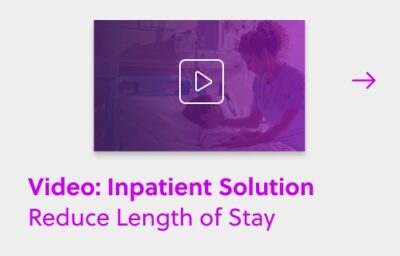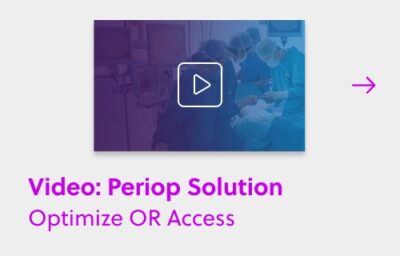By Dr. Durenda Juergensen DNP, RN, NE-BC, LSSGB, FACHE. Durenda is a board-certified nursing executive and Clinical Operations Consultant at Qventus. She’s held numerous leadership roles at health systems and healthcare technology companies. Her expertise supports hospitals in improving operational efficiency through the cultivation and application of data and innovative technologies.
Nurses today face challenges like never before
In healthcare today, as many as five generations of nurses are integral to the delivery of patient care and clinical operations, as described by The Joint Commission. I am proud to be a nurse and am inspired by my nursing colleagues nationwide every day. As a multigenerational workforce, nurses have varying degrees of experience, with each bringing his or her own strengths. Despite these differences, we share one common experience: healthcare delivery is challenging. With hospitals facing increasing pressure on operational, quality, and financial performance, nurses shoulder the burden of these pressures from the bedside to the boardroom.
In spite of the fact that hospitals have invested in EHRs and process improvements, the clinical environment is more complex than ever. The documentation burden of the EHR can pull nurses away from the bedside, competing for time delivering direct care, discharge planning, and discharge teaching. It’s a constant battle for nurses who end up hunting and pecking through a multitude of EHRs, progress notes, and sometimes their own handwritten notes made during interdisciplinary rounds (IDRs) to coordinate care.
COVID-19 only made these problems worse. The past year has intensified the operational challenges of care transitions and put pressure on nurses to “plan-do-learn-improve” at lightning speed. Some nurses even encountered a reversion back to “the old way of doing things” with catering wards of patients to meet volume demands. Still, nurses found new ways to engage with patients and families through technology and shared expertise with the public and each other.
More than ever before, we need healthcare to provide nurses with tools — and a system — that decreases the complexity of the clinical care environment and enables nurses to practice at the top of their license. If we don’t, we’ll continue to face challenges with nursing recruitment and retention, burnout and morale, and nursing leadership issues down the road. We owe this to all generations of nurses to help them excel.
New technology that works for nurses
For too long, hospitals have adopted technology that has only added more tasks for nurses and taken them away from the bedside. Now, leading hospitals are using a real-time operations system to reduce the complexity of the clinical environment for nurses by streamlining operations across the hospital, including in inpatient, ED, perioperative, and command center settings.
For example, in the inpatient setting, a real-time operations system helps nurses across all levels manage care coordination in numerous ways. First, the technology helps streamline the IDR process, using artificial intelligence (AI) and machine learning (ML) to surface predictions about estimated discharge dates and discharge barriers. Next, the system creates transparency and helps automate coordination across the interdisciplinary care teams, thereby reducing the number of back-and-forth phone calls and manual follow-ups that lead to so many headaches for nurses. The technology also equips nursing leaders with real-time data into a unit’s performance and coaching opportunities, so they’re not relying on months-old data reports. At last, this technology is helping us embrace and champion “discharge planning starts at admission!”
I believe that real-time operations can significantly enhance the role of nurses, which compelled me to focus on helping hospitals adopt this technology to benefit nurses. And I’m already seeing this play out at our health system partners. For example, during a recent conversation with a front line nursing leader she exclaimed, “Finally, we have technology that is a resource to help staff!” Now, nurses across all roles and levels can excel and lead using real-time data at their fingertips to enhance care coordination, make actionable decisions, and improve discharge processes, keeping the patient at the center. And this benefits the entire multigenerational nursing workforce, from bedside to the boardroom.
Nurses at the center of care coordination: lead, excel, innovate
Nurses are poised to lead care coordination by improving processes, leveraging data, and getting ahead of operational barriers to patient flow. Healthcare delivery challenges faced by nurses will continue and will not resolve quickly. Thus, nurses across all levels and generations can excel in knowledge sharing, self-care and resilience to meet the needs of the patients we serve across all venues of care delivery. Mentoring will be even more critical for the multi-generational workforce to share best practices and embrace reverse mentoring. Just as important as mentoring is embracing self-care — as we refresh and renew from today, we need to prepare for the “tomorrows” coming our way.
Today nurses are moving from the “impossible” to “mission possible” care coordination by excelling, leading and innovating. Nurses achieve successes with technology that embraces people, processes, plus data to drive action. After all, Florence Nightingale understood the power of data for nurses to rely on and to make decisions to improve patient care. Now, over 200 years later, data has transitioned away from retrospective reports to prescriptive and predictive data in real-time.
All generations of nurses desire intuitive, easy-to-use tools to support workflows and reduce the complexity of technology. Nurses can use technology to improve care coordination and alignment to the patient’s needs. Nurses, it’s time to transform care coordination! As we look ahead to the future of nursing and prepare the next generation of nurses, now is our chance to transform the system and reduce the complexity of the clinical care environment.
About Qventus
Qventus is the first real-time operations system for healthcare. Integrating with EHRs, the Qventus platform uses AI and behavioral science to power best-practice solutions for inpatient, ED, perioperative, and command center settings. With hundreds of deployments in health systems and hospitals across the country, including CommonSpirit Health, M Health Fairview, Mercy, and NewYork-Presbyterian, Qventus delivers proven outcomes, including 90% lower excess days per patient and up to 0.8 day reductions in length of stay. For more, visit www.qventus.com.


